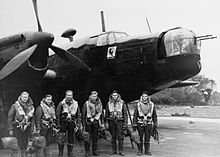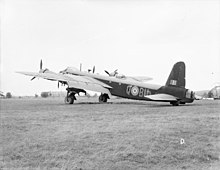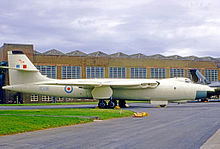No. 214 Squadron RAF
| No. 214 Squadron RAF | |
|---|---|
 An electronic warfare B-17 Fortress Mk III of 214 Squadron, August 1944 | |
| Active | 1917–1920 1935–1977 |
| Country | |
| Branch | |
| Motto(s) | Latin: Ultor in umbris ("Avenging in the shadows") |
| Insignia | |
| Squadron heraldry | A nightjar volant affrontée |
| Squadron codes | 214 (Jan 1937–Apr 1939) UX (Apr 1939–Sep 1939) BU (Sep 1939–Jul 1945) QN, PX* (Nov 1946–Apr 1951, *only used by "C" Flight) |
No. 214 Squadron is a former unit of the Royal Air Force.
History
World War I
No 214 Squadron was formed from No. 14 Squadron Royal Naval Air Service (RNAS), itself formerly No. 7A Squadron RNAS only taking on the new number on 9 December 1917. With the creation of the RAF from the Royal Flying Corps and the RNAS on 1 April 1918 it received the number 214.[1] It was later given the fuller title No 214 (Federated Malay States) Squadron.
No. 214 Squadron started with the Handley Page Type O/100 bomber but soon got the more powerful O/400 in the middle of 1918 with which it continued to fly against German strategic targets. From 29 June to 23 October 1918, 214 Squadron was based at RAF Saint Inglevert.[2]
Between the Wars
Post war the squadron was moved to Egypt but it was disbanded on 1 February 1920 with its crew and aircraft merged into No. 216 Squadron RAF.
On 16 September 1935 'B' Flight of No. 9 Squadron RAF was used to create a new 214 Squadron. Again a bomber squadron it had the Vickers Virginia Mk. X night-bombers at RAF Boscombe Down.
World War II


By the outbreak of the Second World War it had re-equipped the Vickers Wellington which were replaced in 1942 with the larger Short Stirling, having moved to RAF Stradishall.
At a time when Stirling losses led to the aircraft being withdrawn from bombing Germany the squadron transferred to RAF Downham Market in December 1943.[3] In January 1944, the squadron was converted to special operations, joining No. 100 Group RAF for electronic countermeasures in support of the main bombing operations.
The squadron used the Boeing Fortress Mk II and Mk III and Stirlings. They used the jamming system codenamed "Airborne Cigar" (ABC) to block German night fighter communications. German speaking radio operators would identify and jam the ground controllers broadcasts and also pose as ground controllers themselves with the intention of steering the night fighters away from the bomber streams.[4] At least some of 214 Squadron's B-17s were equipped with 'Piperack' which countered the Germans' Lichtenstein SN-2 aerial intercept radar.[5]

Postwar
It operated the Vickers Valiant from RAF Marham, from 21 January 1956 until 28 February 1965. Leonard Trent, a Victoria Cross winner, was the first CO of the Valiant squadron. The Valiant was at first active as a V bomber but was then converted to tankers. Disbanded in 1965 it reformed the following year with the Handley Page Victor tanker and continued until disbanded finally in 1977.
Accidents and incidents
- On 19 August 1968 Victor K1 XH646 collided in mid-air near Holt, Norfolk in bad weather with a 213 Squadron English Electric Canberra WT325, all four crew members of the Victor died.[6]
- On 10/11 August 1943, Flight Sergeant Harry Ernest Hall was pilot of a crippled aircraft which was returning from operations, after losing an engine. When approaching Bexhill on the South Coast of England the aircraft ran out of fuel and dived almost out of control into the sea. The crew were temporarily knocked out by the impact and the aircraft filled rapidly with water. F/S Hall was the first to recover and his first thoughts were for the safety of his crew. He found the wireless operator injured and floating just below the astrodome, and in spite of the rapidly rising water and with complete disregard for his own safety, he succeeded in extricating him from the aircraft and securing him safely in a dingy. He then returned to the aircraft to search for the navigator and flight engineer who were missing.[7] Five members of the crew were subsequently picked up by an air/sea rescue launch, two died. In a desperate situation, aggravated by darkness, F/S Hall displayed extreme courage and coolness throughout. Unfortunately F/S Hall was killed on operations six weeks later. For his exploits F/S Hall was awarded the British Empire Medal by His Majesty King George VI, presented to his mother posthumously.[8]
References
Citations
- ^ All RNAS squadrons were renumbered by adding 200.
- ^ "Saint-Inglevert". Anciens Aerodromes (in French). 2015. Retrieved 16 October 2015.
- ^ Hilling, John B. (1995). Strike Hard : A bomber airfield at war : RAF Downham Market and its squadrons, 1942–46 (1st ed.). Stroud, UK: Sutton. ISBN 0750909692.
- ^ "Obituaries: John Hereford". The Daily Telegraph. London: TMG. 13 December 2007. Retrieved 16 October 2015.
- ^ Peden, Murray (1997). A Thousand Shall Fall (Updated ed.). Toronto: Stoddart. p. 394. ISBN 0-7737-5967-0.
- ^ "No. 214 (Federated Malay States) Squadron Royal Air Force: Crews & Losses". 214squadron.org.uk. 2015. Retrieved 16 October 2015.
- ^ "No. 36245". The London Gazette (invalid
|supp=(help)). 9 November 1943. - ^ "No. 214 (Federated Malay States) Squadron Royal Air Force: Personnel (H)". 214squadron.org.uk. 2015. Retrieved 16 October 2015.
Bibliography
- Murray, Peden (4 December 2004). A Thousand Shall Fall. Toronto: Dundurn Press. ISBN 978-1-55002-454-8.
- History of No.'s 211–215 Squadrons at RAF Web
